Capital Budgeting Analysis: Chapter 10 Fundamentals of Finance
VerifiedAdded on 2020/05/28
|34
|7926
|150
Homework Assignment
AI Summary
This assignment focuses on the core concepts of capital budgeting, a critical process for financial managers in making investment decisions. It explores the importance of capital budgeting, the classification of investment projects (independent, mutually exclusive, and contingent), and key terms like cost of capital and capital rationing. The assignment delves into the Net Present Value (NPV) method, explaining how to calculate it and its role in maximizing shareholder wealth. It also covers the limitations of the payback period and the accounting rate of return (ARR). Furthermore, the assignment explains the Internal Rate of Return (IRR) method, comparing it to NPV and discussing the conditions under which they may yield different results. Finally, it emphasizes the importance of post-audit reviews for capital projects. The assignment includes examples of NPV calculations and the importance of cash flow, discount rates, and making informed financial decisions.
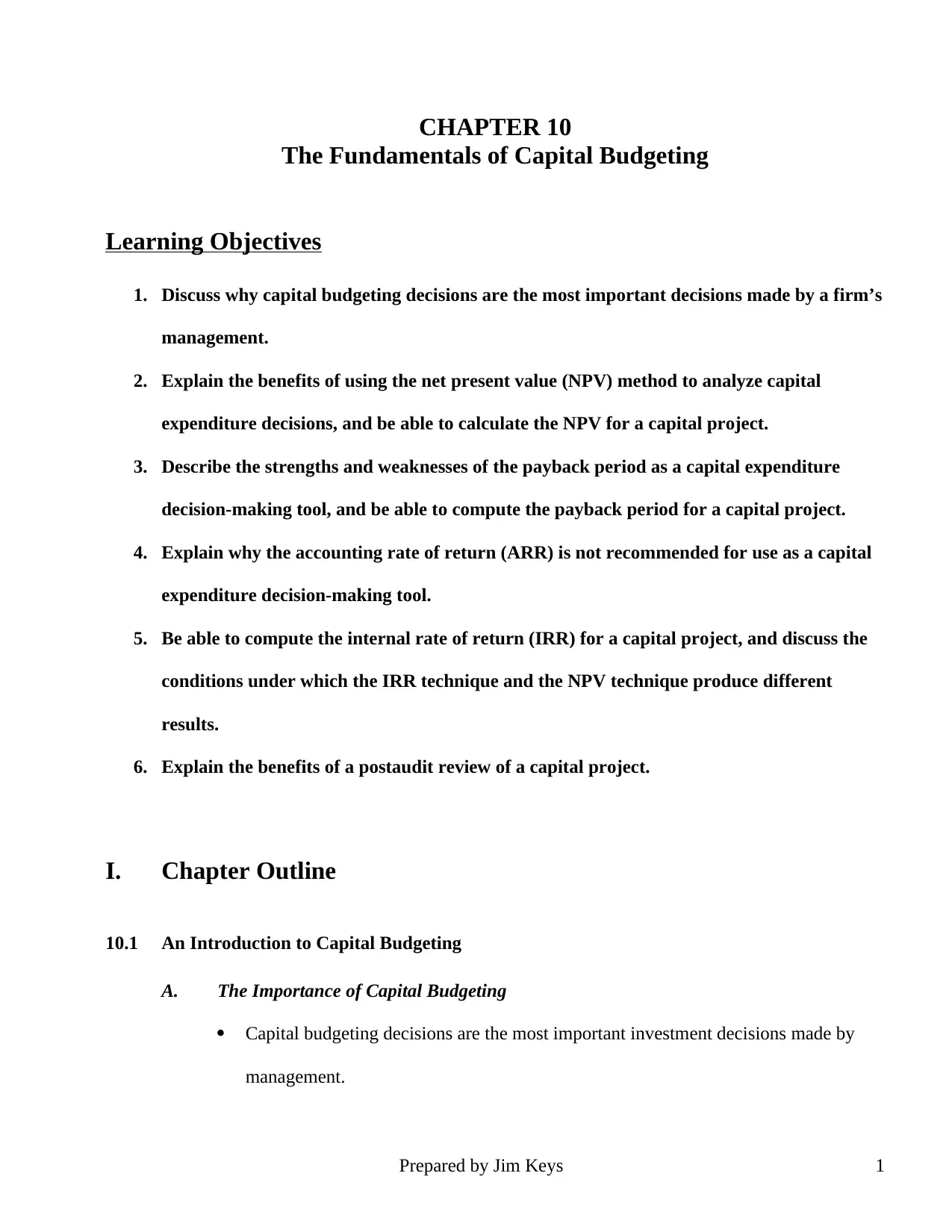
CHAPTER 10
The Fundamentals of Capital Budgeting
Learning Objectives
1. Discuss why capital budgeting decisions are the most important decisions made by a firm’s
management.
2. Explain the benefits of using the net present value (NPV) method to analyze capital
expenditure decisions, and be able to calculate the NPV for a capital project.
3. Describe the strengths and weaknesses of the payback period as a capital expenditure
decision-making tool, and be able to compute the payback period for a capital project.
4. Explain why the accounting rate of return (ARR) is not recommended for use as a capital
expenditure decision-making tool.
5. Be able to compute the internal rate of return (IRR) for a capital project, and discuss the
conditions under which the IRR technique and the NPV technique produce different
results.
6. Explain the benefits of a postaudit review of a capital project.
I. Chapter Outline
10.1 An Introduction to Capital Budgeting
A. The Importance of Capital Budgeting
Capital budgeting decisions are the most important investment decisions made by
management.
Prepared by Jim Keys 1
The Fundamentals of Capital Budgeting
Learning Objectives
1. Discuss why capital budgeting decisions are the most important decisions made by a firm’s
management.
2. Explain the benefits of using the net present value (NPV) method to analyze capital
expenditure decisions, and be able to calculate the NPV for a capital project.
3. Describe the strengths and weaknesses of the payback period as a capital expenditure
decision-making tool, and be able to compute the payback period for a capital project.
4. Explain why the accounting rate of return (ARR) is not recommended for use as a capital
expenditure decision-making tool.
5. Be able to compute the internal rate of return (IRR) for a capital project, and discuss the
conditions under which the IRR technique and the NPV technique produce different
results.
6. Explain the benefits of a postaudit review of a capital project.
I. Chapter Outline
10.1 An Introduction to Capital Budgeting
A. The Importance of Capital Budgeting
Capital budgeting decisions are the most important investment decisions made by
management.
Prepared by Jim Keys 1
Paraphrase This Document
Need a fresh take? Get an instant paraphrase of this document with our AI Paraphraser
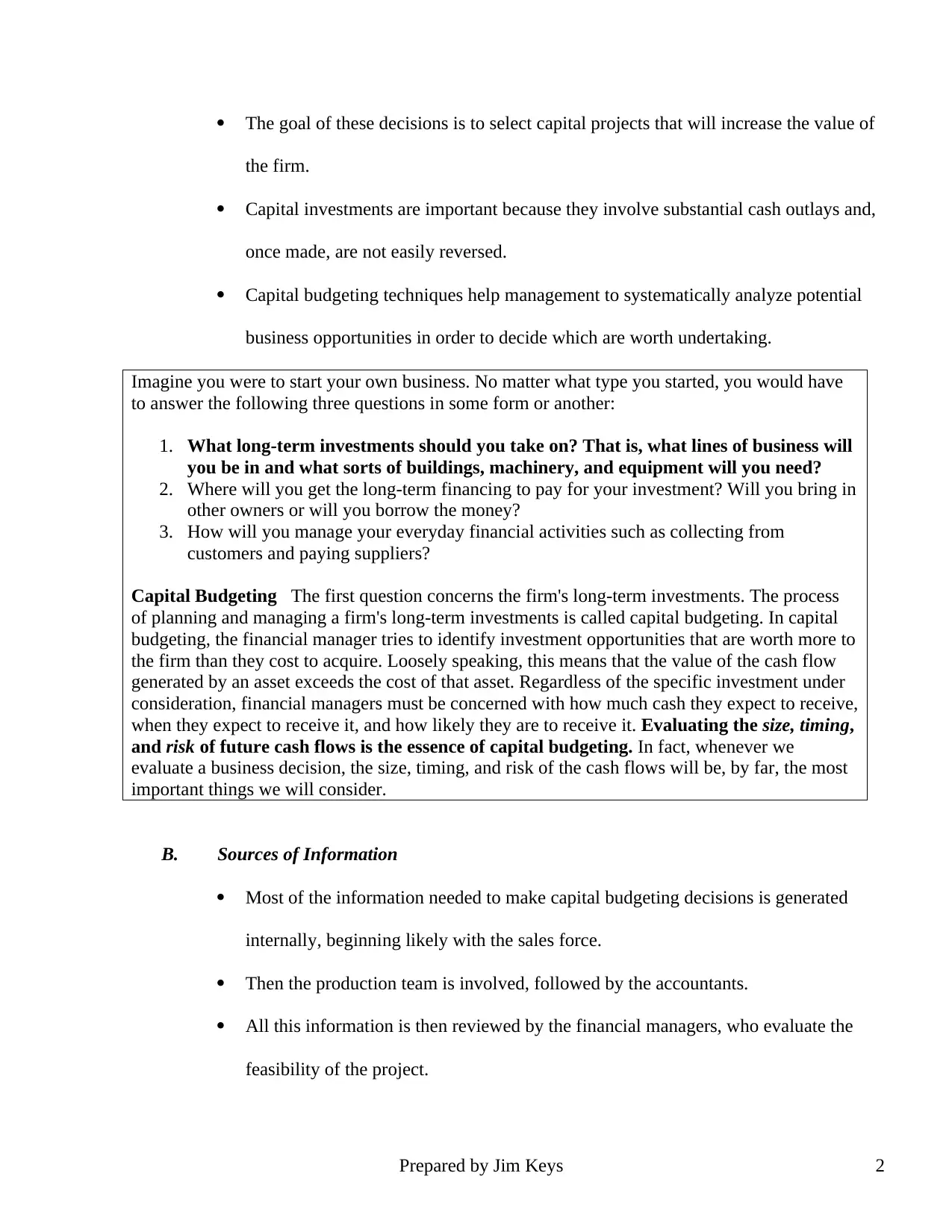
The goal of these decisions is to select capital projects that will increase the value of
the firm.
Capital investments are important because they involve substantial cash outlays and,
once made, are not easily reversed.
Capital budgeting techniques help management to systematically analyze potential
business opportunities in order to decide which are worth undertaking.
Imagine you were to start your own business. No matter what type you started, you would have
to answer the following three questions in some form or another:
1. What long-term investments should you take on? That is, what lines of business will
you be in and what sorts of buildings, machinery, and equipment will you need?
2. Where will you get the long-term financing to pay for your investment? Will you bring in
other owners or will you borrow the money?
3. How will you manage your everyday financial activities such as collecting from
customers and paying suppliers?
Capital Budgeting The first question concerns the firm's long-term investments. The process
of planning and managing a firm's long-term investments is called capital budgeting. In capital
budgeting, the financial manager tries to identify investment opportunities that are worth more to
the firm than they cost to acquire. Loosely speaking, this means that the value of the cash flow
generated by an asset exceeds the cost of that asset. Regardless of the specific investment under
consideration, financial managers must be concerned with how much cash they expect to receive,
when they expect to receive it, and how likely they are to receive it. Evaluating the size, timing,
and risk of future cash flows is the essence of capital budgeting. In fact, whenever we
evaluate a business decision, the size, timing, and risk of the cash flows will be, by far, the most
important things we will consider.
B. Sources of Information
Most of the information needed to make capital budgeting decisions is generated
internally, beginning likely with the sales force.
Then the production team is involved, followed by the accountants.
All this information is then reviewed by the financial managers, who evaluate the
feasibility of the project.
Prepared by Jim Keys 2
the firm.
Capital investments are important because they involve substantial cash outlays and,
once made, are not easily reversed.
Capital budgeting techniques help management to systematically analyze potential
business opportunities in order to decide which are worth undertaking.
Imagine you were to start your own business. No matter what type you started, you would have
to answer the following three questions in some form or another:
1. What long-term investments should you take on? That is, what lines of business will
you be in and what sorts of buildings, machinery, and equipment will you need?
2. Where will you get the long-term financing to pay for your investment? Will you bring in
other owners or will you borrow the money?
3. How will you manage your everyday financial activities such as collecting from
customers and paying suppliers?
Capital Budgeting The first question concerns the firm's long-term investments. The process
of planning and managing a firm's long-term investments is called capital budgeting. In capital
budgeting, the financial manager tries to identify investment opportunities that are worth more to
the firm than they cost to acquire. Loosely speaking, this means that the value of the cash flow
generated by an asset exceeds the cost of that asset. Regardless of the specific investment under
consideration, financial managers must be concerned with how much cash they expect to receive,
when they expect to receive it, and how likely they are to receive it. Evaluating the size, timing,
and risk of future cash flows is the essence of capital budgeting. In fact, whenever we
evaluate a business decision, the size, timing, and risk of the cash flows will be, by far, the most
important things we will consider.
B. Sources of Information
Most of the information needed to make capital budgeting decisions is generated
internally, beginning likely with the sales force.
Then the production team is involved, followed by the accountants.
All this information is then reviewed by the financial managers, who evaluate the
feasibility of the project.
Prepared by Jim Keys 2
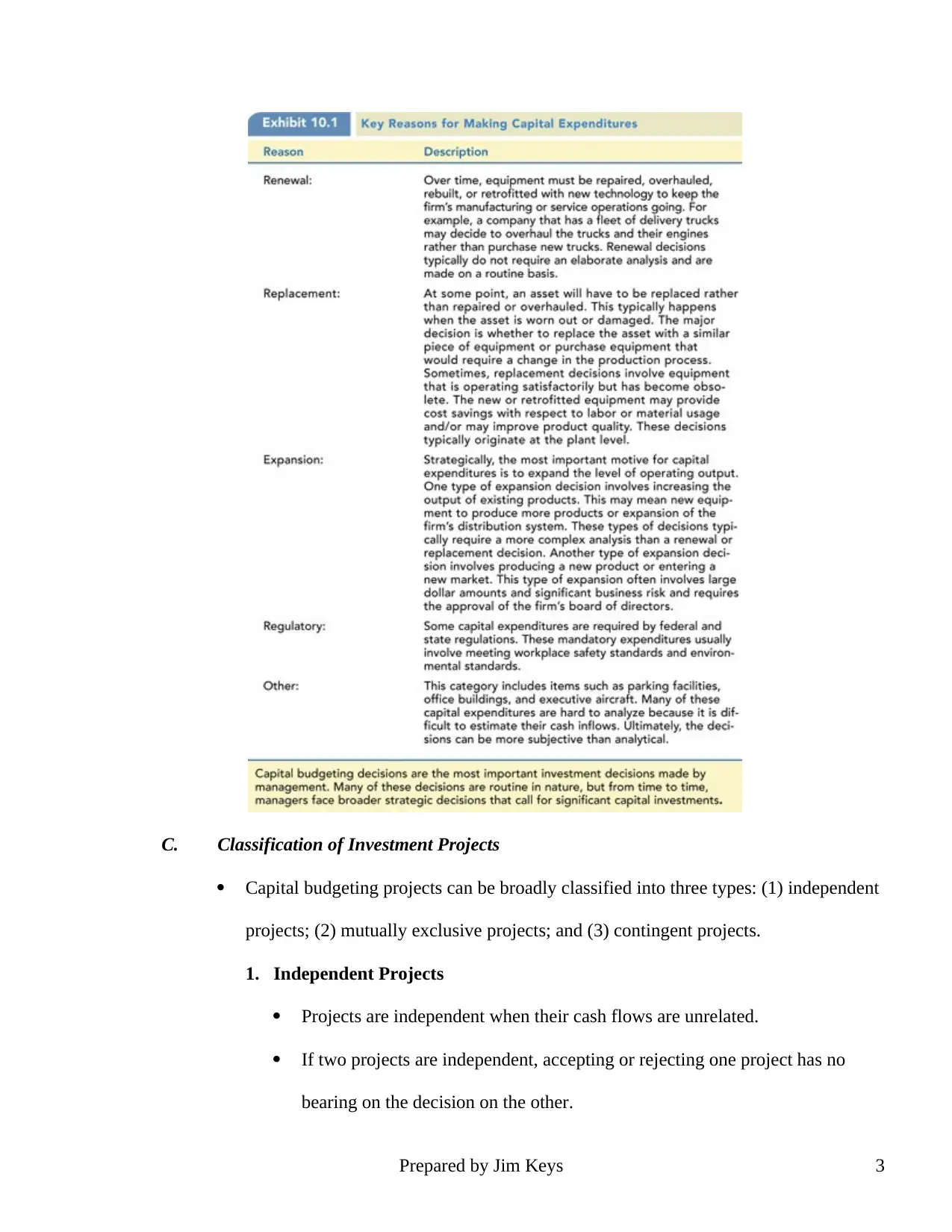
C. Classification of Investment Projects
Capital budgeting projects can be broadly classified into three types: (1) independent
projects; (2) mutually exclusive projects; and (3) contingent projects.
1. Independent Projects
Projects are independent when their cash flows are unrelated.
If two projects are independent, accepting or rejecting one project has no
bearing on the decision on the other.
Prepared by Jim Keys 3
Capital budgeting projects can be broadly classified into three types: (1) independent
projects; (2) mutually exclusive projects; and (3) contingent projects.
1. Independent Projects
Projects are independent when their cash flows are unrelated.
If two projects are independent, accepting or rejecting one project has no
bearing on the decision on the other.
Prepared by Jim Keys 3
⊘ This is a preview!⊘
Do you want full access?
Subscribe today to unlock all pages.

Trusted by 1+ million students worldwide
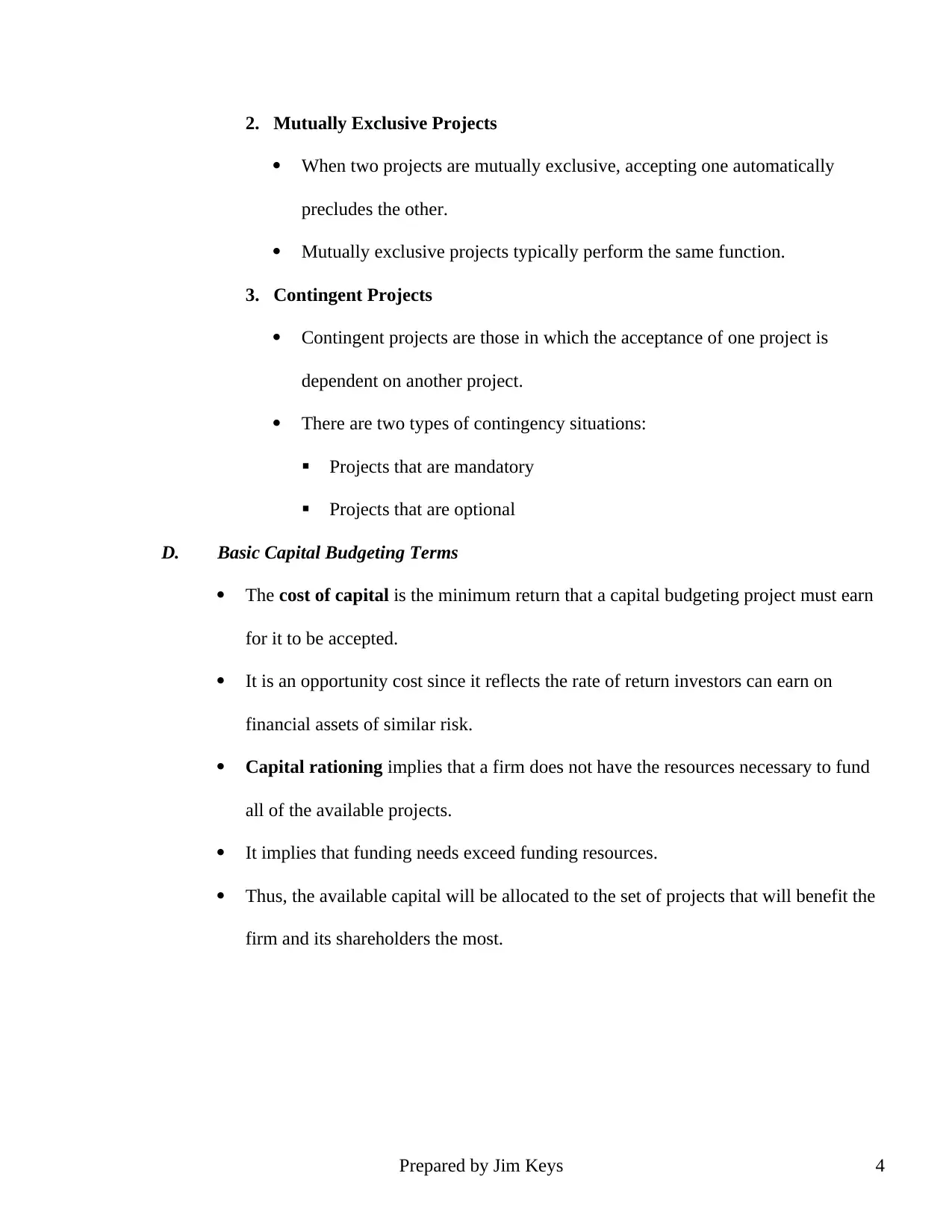
2. Mutually Exclusive Projects
When two projects are mutually exclusive, accepting one automatically
precludes the other.
Mutually exclusive projects typically perform the same function.
3. Contingent Projects
Contingent projects are those in which the acceptance of one project is
dependent on another project.
There are two types of contingency situations:
Projects that are mandatory
Projects that are optional
D. Basic Capital Budgeting Terms
The cost of capital is the minimum return that a capital budgeting project must earn
for it to be accepted.
It is an opportunity cost since it reflects the rate of return investors can earn on
financial assets of similar risk.
Capital rationing implies that a firm does not have the resources necessary to fund
all of the available projects.
It implies that funding needs exceed funding resources.
Thus, the available capital will be allocated to the set of projects that will benefit the
firm and its shareholders the most.
Prepared by Jim Keys 4
When two projects are mutually exclusive, accepting one automatically
precludes the other.
Mutually exclusive projects typically perform the same function.
3. Contingent Projects
Contingent projects are those in which the acceptance of one project is
dependent on another project.
There are two types of contingency situations:
Projects that are mandatory
Projects that are optional
D. Basic Capital Budgeting Terms
The cost of capital is the minimum return that a capital budgeting project must earn
for it to be accepted.
It is an opportunity cost since it reflects the rate of return investors can earn on
financial assets of similar risk.
Capital rationing implies that a firm does not have the resources necessary to fund
all of the available projects.
It implies that funding needs exceed funding resources.
Thus, the available capital will be allocated to the set of projects that will benefit the
firm and its shareholders the most.
Prepared by Jim Keys 4
Paraphrase This Document
Need a fresh take? Get an instant paraphrase of this document with our AI Paraphraser
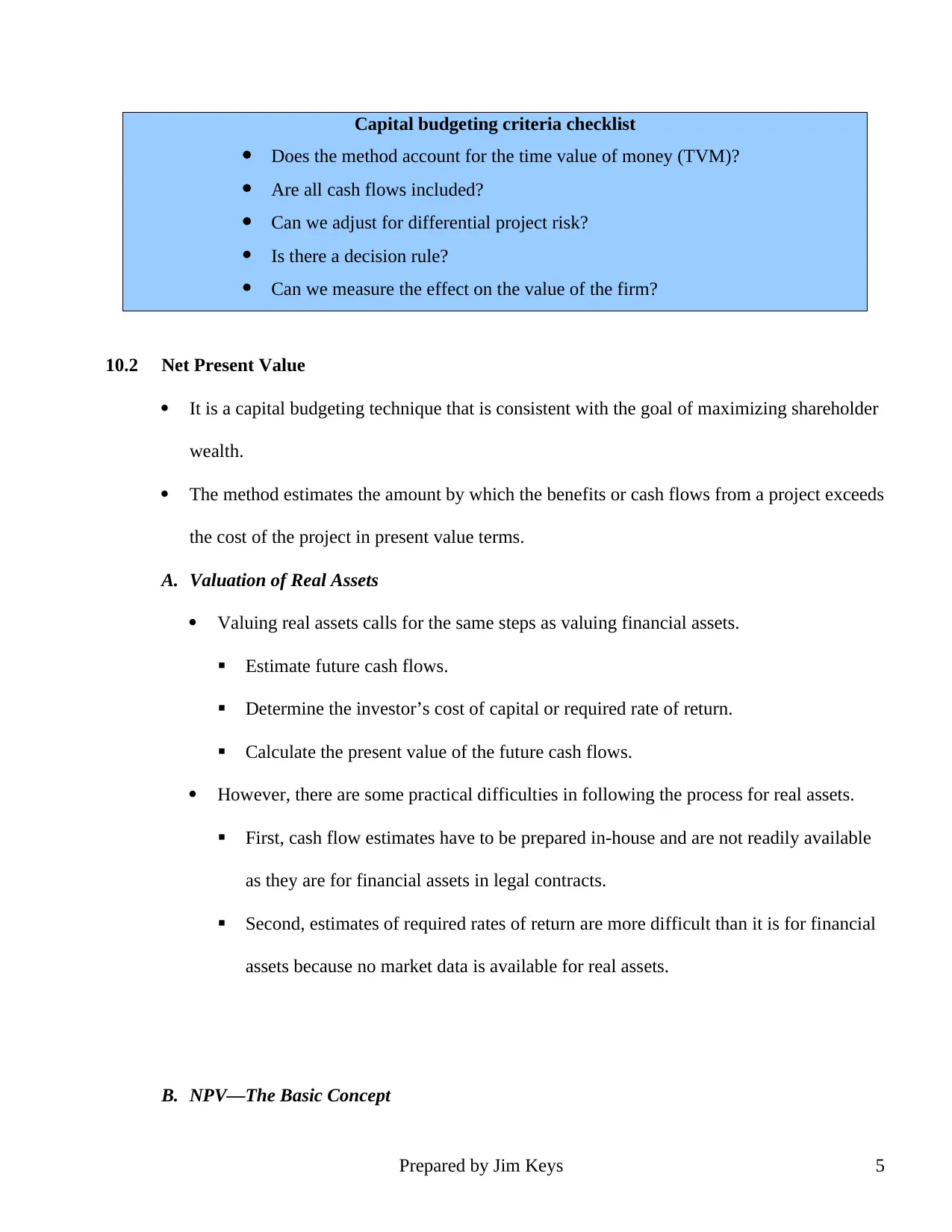
Capital budgeting criteria checklist
Does the method account for the time value of money (TVM)?
Are all cash flows included?
Can we adjust for differential project risk?
Is there a decision rule?
Can we measure the effect on the value of the firm?
10.2 Net Present Value
It is a capital budgeting technique that is consistent with the goal of maximizing shareholder
wealth.
The method estimates the amount by which the benefits or cash flows from a project exceeds
the cost of the project in present value terms.
A. Valuation of Real Assets
Valuing real assets calls for the same steps as valuing financial assets.
Estimate future cash flows.
Determine the investor’s cost of capital or required rate of return.
Calculate the present value of the future cash flows.
However, there are some practical difficulties in following the process for real assets.
First, cash flow estimates have to be prepared in-house and are not readily available
as they are for financial assets in legal contracts.
Second, estimates of required rates of return are more difficult than it is for financial
assets because no market data is available for real assets.
B. NPV—The Basic Concept
Prepared by Jim Keys 5
Does the method account for the time value of money (TVM)?
Are all cash flows included?
Can we adjust for differential project risk?
Is there a decision rule?
Can we measure the effect on the value of the firm?
10.2 Net Present Value
It is a capital budgeting technique that is consistent with the goal of maximizing shareholder
wealth.
The method estimates the amount by which the benefits or cash flows from a project exceeds
the cost of the project in present value terms.
A. Valuation of Real Assets
Valuing real assets calls for the same steps as valuing financial assets.
Estimate future cash flows.
Determine the investor’s cost of capital or required rate of return.
Calculate the present value of the future cash flows.
However, there are some practical difficulties in following the process for real assets.
First, cash flow estimates have to be prepared in-house and are not readily available
as they are for financial assets in legal contracts.
Second, estimates of required rates of return are more difficult than it is for financial
assets because no market data is available for real assets.
B. NPV—The Basic Concept
Prepared by Jim Keys 5
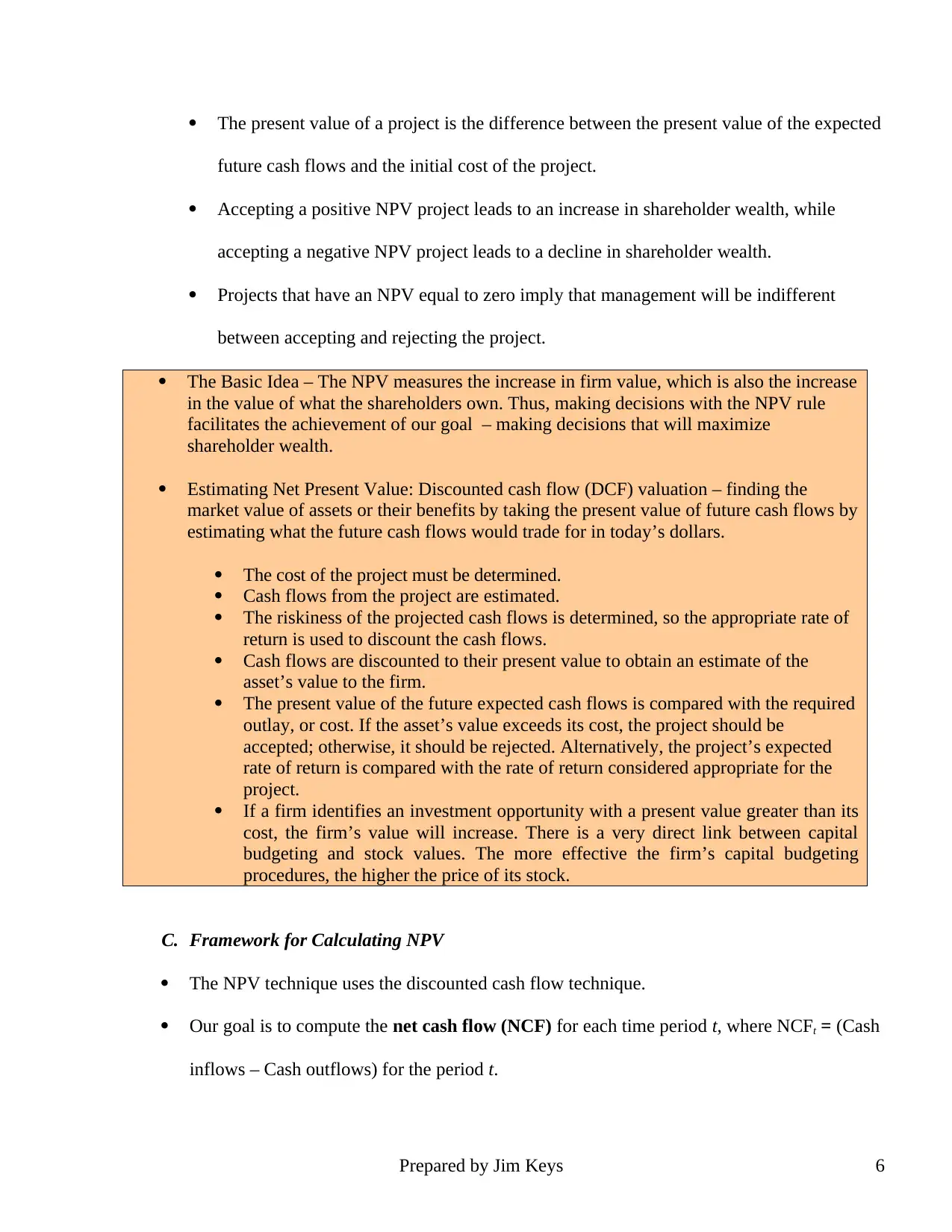
The present value of a project is the difference between the present value of the expected
future cash flows and the initial cost of the project.
Accepting a positive NPV project leads to an increase in shareholder wealth, while
accepting a negative NPV project leads to a decline in shareholder wealth.
Projects that have an NPV equal to zero imply that management will be indifferent
between accepting and rejecting the project.
The Basic Idea – The NPV measures the increase in firm value, which is also the increase
in the value of what the shareholders own. Thus, making decisions with the NPV rule
facilitates the achievement of our goal – making decisions that will maximize
shareholder wealth.
Estimating Net Present Value: Discounted cash flow (DCF) valuation – finding the
market value of assets or their benefits by taking the present value of future cash flows by
estimating what the future cash flows would trade for in today’s dollars.
The cost of the project must be determined.
Cash flows from the project are estimated.
The riskiness of the projected cash flows is determined, so the appropriate rate of
return is used to discount the cash flows.
Cash flows are discounted to their present value to obtain an estimate of the
asset’s value to the firm.
The present value of the future expected cash flows is compared with the required
outlay, or cost. If the asset’s value exceeds its cost, the project should be
accepted; otherwise, it should be rejected. Alternatively, the project’s expected
rate of return is compared with the rate of return considered appropriate for the
project.
If a firm identifies an investment opportunity with a present value greater than its
cost, the firm’s value will increase. There is a very direct link between capital
budgeting and stock values. The more effective the firm’s capital budgeting
procedures, the higher the price of its stock.
C. Framework for Calculating NPV
The NPV technique uses the discounted cash flow technique.
Our goal is to compute the net cash flow (NCF) for each time period t, where NCFt = (Cash
inflows – Cash outflows) for the period t.
Prepared by Jim Keys 6
future cash flows and the initial cost of the project.
Accepting a positive NPV project leads to an increase in shareholder wealth, while
accepting a negative NPV project leads to a decline in shareholder wealth.
Projects that have an NPV equal to zero imply that management will be indifferent
between accepting and rejecting the project.
The Basic Idea – The NPV measures the increase in firm value, which is also the increase
in the value of what the shareholders own. Thus, making decisions with the NPV rule
facilitates the achievement of our goal – making decisions that will maximize
shareholder wealth.
Estimating Net Present Value: Discounted cash flow (DCF) valuation – finding the
market value of assets or their benefits by taking the present value of future cash flows by
estimating what the future cash flows would trade for in today’s dollars.
The cost of the project must be determined.
Cash flows from the project are estimated.
The riskiness of the projected cash flows is determined, so the appropriate rate of
return is used to discount the cash flows.
Cash flows are discounted to their present value to obtain an estimate of the
asset’s value to the firm.
The present value of the future expected cash flows is compared with the required
outlay, or cost. If the asset’s value exceeds its cost, the project should be
accepted; otherwise, it should be rejected. Alternatively, the project’s expected
rate of return is compared with the rate of return considered appropriate for the
project.
If a firm identifies an investment opportunity with a present value greater than its
cost, the firm’s value will increase. There is a very direct link between capital
budgeting and stock values. The more effective the firm’s capital budgeting
procedures, the higher the price of its stock.
C. Framework for Calculating NPV
The NPV technique uses the discounted cash flow technique.
Our goal is to compute the net cash flow (NCF) for each time period t, where NCFt = (Cash
inflows – Cash outflows) for the period t.
Prepared by Jim Keys 6
⊘ This is a preview!⊘
Do you want full access?
Subscribe today to unlock all pages.

Trusted by 1+ million students worldwide
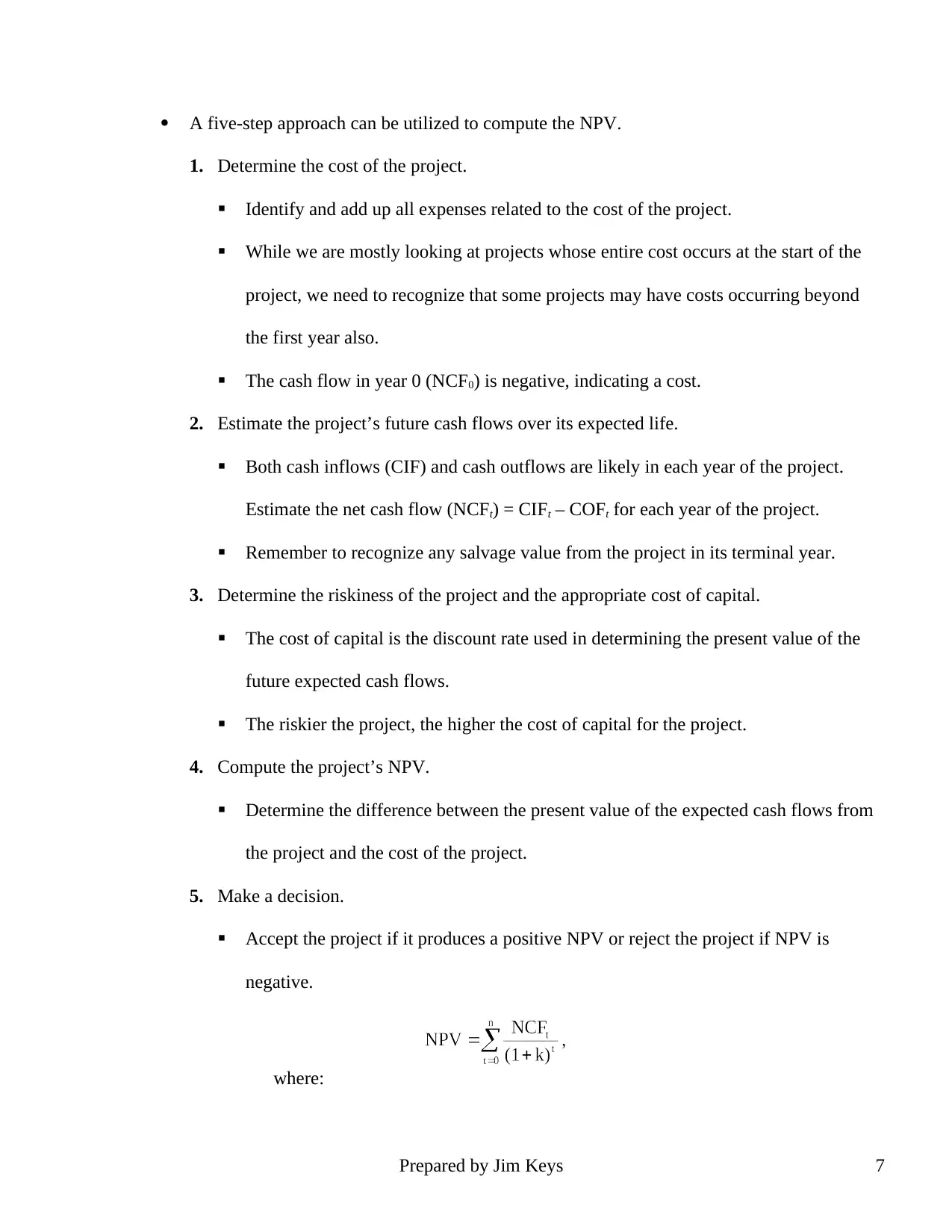
A five-step approach can be utilized to compute the NPV.
1. Determine the cost of the project.
Identify and add up all expenses related to the cost of the project.
While we are mostly looking at projects whose entire cost occurs at the start of the
project, we need to recognize that some projects may have costs occurring beyond
the first year also.
The cash flow in year 0 (NCF0) is negative, indicating a cost.
2. Estimate the project’s future cash flows over its expected life.
Both cash inflows (CIF) and cash outflows are likely in each year of the project.
Estimate the net cash flow (NCFt) = CIFt – COFt for each year of the project.
Remember to recognize any salvage value from the project in its terminal year.
3. Determine the riskiness of the project and the appropriate cost of capital.
The cost of capital is the discount rate used in determining the present value of the
future expected cash flows.
The riskier the project, the higher the cost of capital for the project.
4. Compute the project’s NPV.
Determine the difference between the present value of the expected cash flows from
the project and the cost of the project.
5. Make a decision.
Accept the project if it produces a positive NPV or reject the project if NPV is
negative.
where:
Prepared by Jim Keys 7
1. Determine the cost of the project.
Identify and add up all expenses related to the cost of the project.
While we are mostly looking at projects whose entire cost occurs at the start of the
project, we need to recognize that some projects may have costs occurring beyond
the first year also.
The cash flow in year 0 (NCF0) is negative, indicating a cost.
2. Estimate the project’s future cash flows over its expected life.
Both cash inflows (CIF) and cash outflows are likely in each year of the project.
Estimate the net cash flow (NCFt) = CIFt – COFt for each year of the project.
Remember to recognize any salvage value from the project in its terminal year.
3. Determine the riskiness of the project and the appropriate cost of capital.
The cost of capital is the discount rate used in determining the present value of the
future expected cash flows.
The riskier the project, the higher the cost of capital for the project.
4. Compute the project’s NPV.
Determine the difference between the present value of the expected cash flows from
the project and the cost of the project.
5. Make a decision.
Accept the project if it produces a positive NPV or reject the project if NPV is
negative.
where:
Prepared by Jim Keys 7
Paraphrase This Document
Need a fresh take? Get an instant paraphrase of this document with our AI Paraphraser
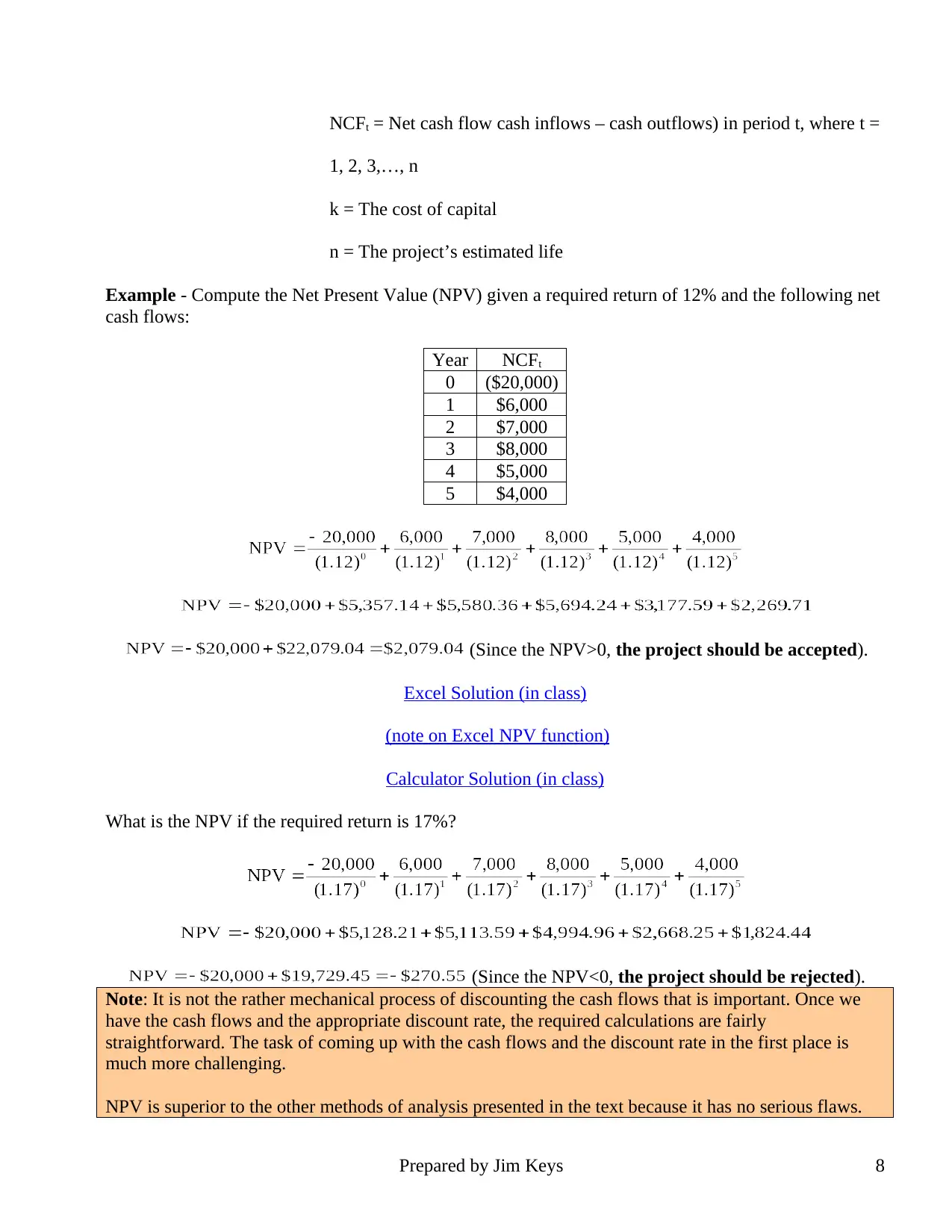
NCFt = Net cash flow cash inflows – cash outflows) in period t, where t =
1, 2, 3,…, n
k = The cost of capital
n = The project’s estimated life
Example - Compute the Net Present Value (NPV) given a required return of 12% and the following net
cash flows:
Year NCFt
0 ($20,000)
1 $6,000
2 $7,000
3 $8,000
4 $5,000
5 $4,000
(Since the NPV>0, the project should be accepted).
Excel Solution (in class)
(note on Excel NPV function)
Calculator Solution (in class)
What is the NPV if the required return is 17%?
(Since the NPV<0, the project should be rejected).
Note: It is not the rather mechanical process of discounting the cash flows that is important. Once we
have the cash flows and the appropriate discount rate, the required calculations are fairly
straightforward. The task of coming up with the cash flows and the discount rate in the first place is
much more challenging.
NPV is superior to the other methods of analysis presented in the text because it has no serious flaws.
Prepared by Jim Keys 8
1, 2, 3,…, n
k = The cost of capital
n = The project’s estimated life
Example - Compute the Net Present Value (NPV) given a required return of 12% and the following net
cash flows:
Year NCFt
0 ($20,000)
1 $6,000
2 $7,000
3 $8,000
4 $5,000
5 $4,000
(Since the NPV>0, the project should be accepted).
Excel Solution (in class)
(note on Excel NPV function)
Calculator Solution (in class)
What is the NPV if the required return is 17%?
(Since the NPV<0, the project should be rejected).
Note: It is not the rather mechanical process of discounting the cash flows that is important. Once we
have the cash flows and the appropriate discount rate, the required calculations are fairly
straightforward. The task of coming up with the cash flows and the discount rate in the first place is
much more challenging.
NPV is superior to the other methods of analysis presented in the text because it has no serious flaws.
Prepared by Jim Keys 8
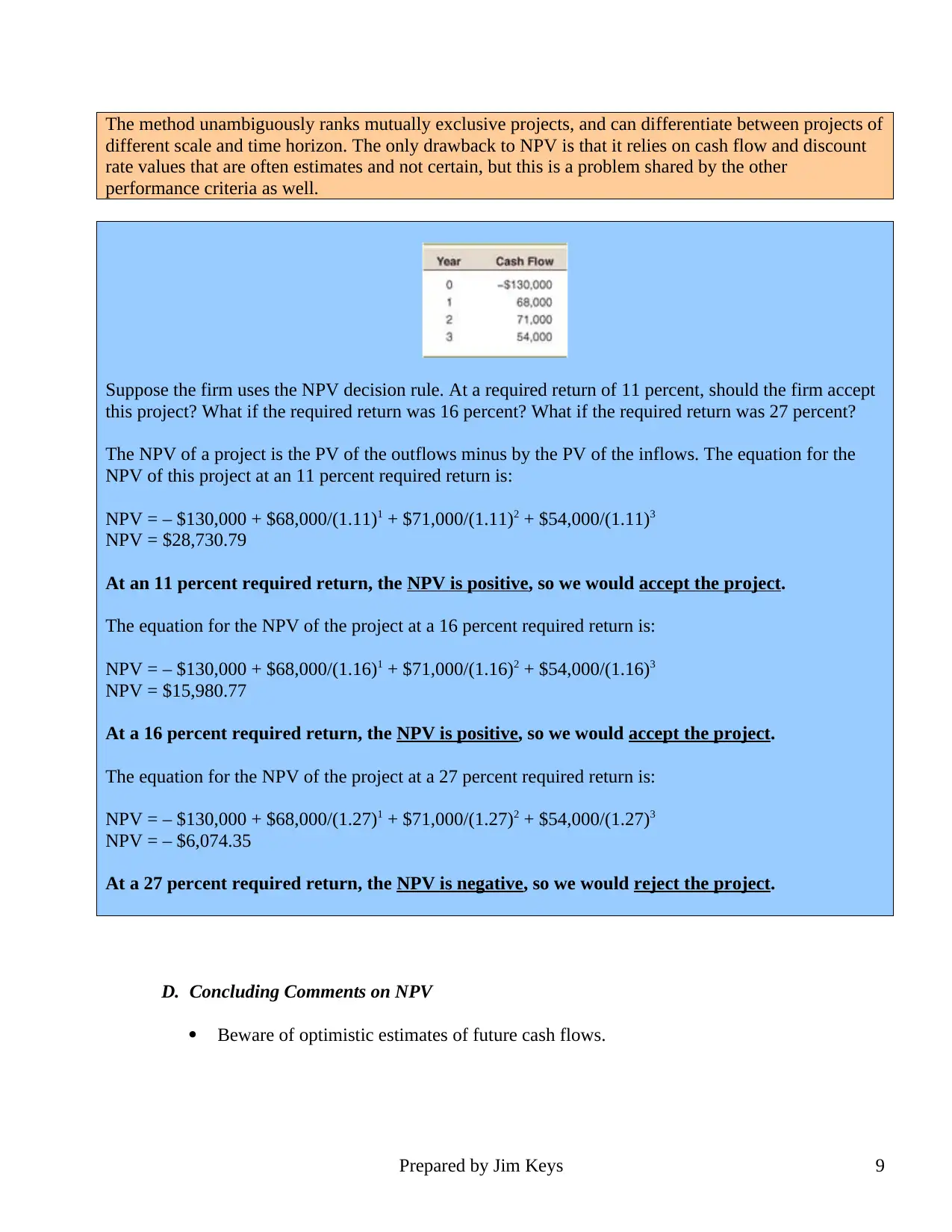
The method unambiguously ranks mutually exclusive projects, and can differentiate between projects of
different scale and time horizon. The only drawback to NPV is that it relies on cash flow and discount
rate values that are often estimates and not certain, but this is a problem shared by the other
performance criteria as well.
Suppose the firm uses the NPV decision rule. At a required return of 11 percent, should the firm accept
this project? What if the required return was 16 percent? What if the required return was 27 percent?
The NPV of a project is the PV of the outflows minus by the PV of the inflows. The equation for the
NPV of this project at an 11 percent required return is:
NPV = – $130,000 + $68,000/(1.11)1 + $71,000/(1.11)2 + $54,000/(1.11)3
NPV = $28,730.79
At an 11 percent required return, the NPV is positive, so we would accept the project.
The equation for the NPV of the project at a 16 percent required return is:
NPV = – $130,000 + $68,000/(1.16)1 + $71,000/(1.16)2 + $54,000/(1.16)3
NPV = $15,980.77
At a 16 percent required return, the NPV is positive, so we would accept the project.
The equation for the NPV of the project at a 27 percent required return is:
NPV = – $130,000 + $68,000/(1.27)1 + $71,000/(1.27)2 + $54,000/(1.27)3
NPV = – $6,074.35
At a 27 percent required return, the NPV is negative, so we would reject the project.
D. Concluding Comments on NPV
Beware of optimistic estimates of future cash flows.
Prepared by Jim Keys 9
different scale and time horizon. The only drawback to NPV is that it relies on cash flow and discount
rate values that are often estimates and not certain, but this is a problem shared by the other
performance criteria as well.
Suppose the firm uses the NPV decision rule. At a required return of 11 percent, should the firm accept
this project? What if the required return was 16 percent? What if the required return was 27 percent?
The NPV of a project is the PV of the outflows minus by the PV of the inflows. The equation for the
NPV of this project at an 11 percent required return is:
NPV = – $130,000 + $68,000/(1.11)1 + $71,000/(1.11)2 + $54,000/(1.11)3
NPV = $28,730.79
At an 11 percent required return, the NPV is positive, so we would accept the project.
The equation for the NPV of the project at a 16 percent required return is:
NPV = – $130,000 + $68,000/(1.16)1 + $71,000/(1.16)2 + $54,000/(1.16)3
NPV = $15,980.77
At a 16 percent required return, the NPV is positive, so we would accept the project.
The equation for the NPV of the project at a 27 percent required return is:
NPV = – $130,000 + $68,000/(1.27)1 + $71,000/(1.27)2 + $54,000/(1.27)3
NPV = – $6,074.35
At a 27 percent required return, the NPV is negative, so we would reject the project.
D. Concluding Comments on NPV
Beware of optimistic estimates of future cash flows.
Prepared by Jim Keys 9
⊘ This is a preview!⊘
Do you want full access?
Subscribe today to unlock all pages.

Trusted by 1+ million students worldwide
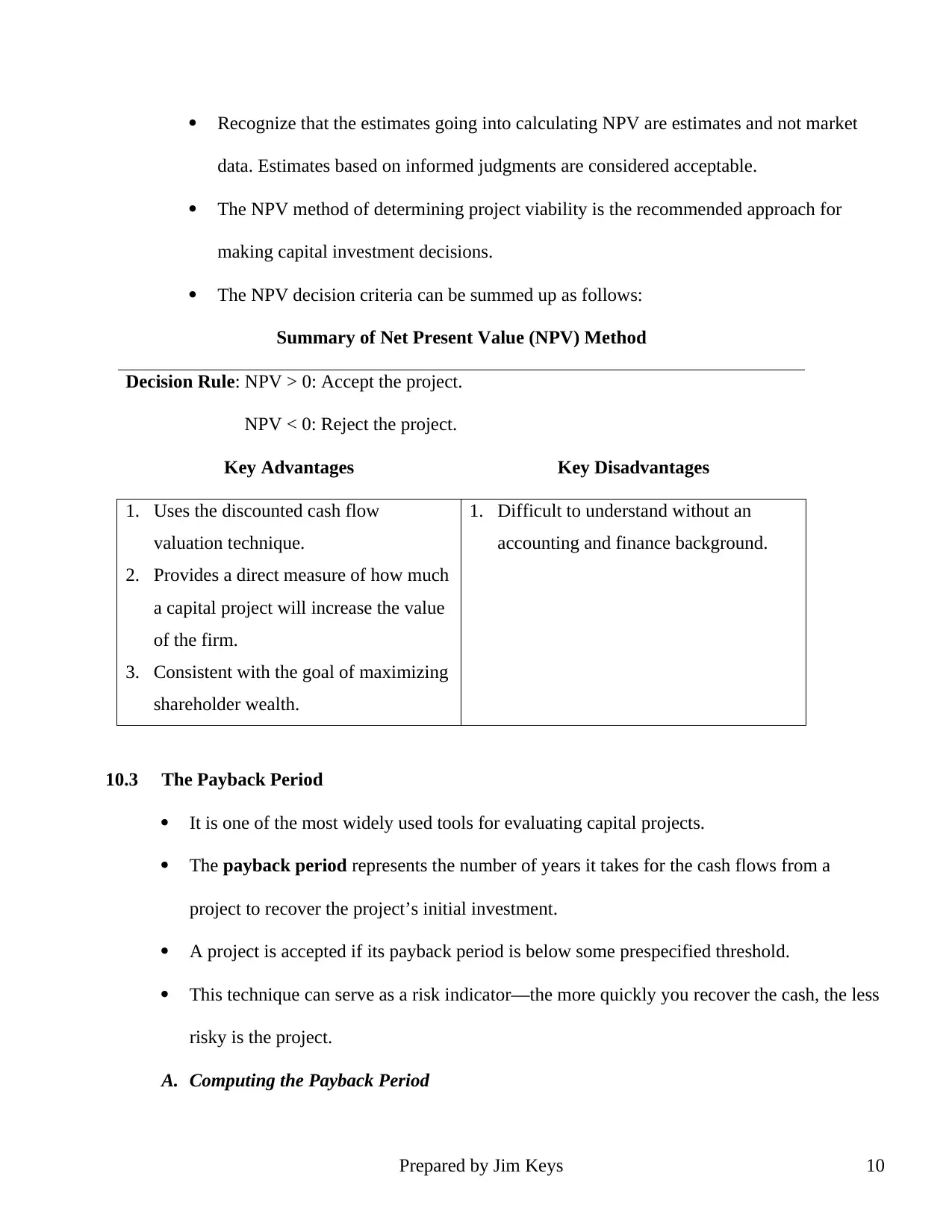
Recognize that the estimates going into calculating NPV are estimates and not market
data. Estimates based on informed judgments are considered acceptable.
The NPV method of determining project viability is the recommended approach for
making capital investment decisions.
The NPV decision criteria can be summed up as follows:
Summary of Net Present Value (NPV) Method
Decision Rule: NPV > 0: Accept the project.
NPV < 0: Reject the project.
Key Advantages Key Disadvantages
1. Uses the discounted cash flow
valuation technique.
2. Provides a direct measure of how much
a capital project will increase the value
of the firm.
3. Consistent with the goal of maximizing
shareholder wealth.
1. Difficult to understand without an
accounting and finance background.
10.3 The Payback Period
It is one of the most widely used tools for evaluating capital projects.
The payback period represents the number of years it takes for the cash flows from a
project to recover the project’s initial investment.
A project is accepted if its payback period is below some prespecified threshold.
This technique can serve as a risk indicator—the more quickly you recover the cash, the less
risky is the project.
A. Computing the Payback Period
Prepared by Jim Keys 10
data. Estimates based on informed judgments are considered acceptable.
The NPV method of determining project viability is the recommended approach for
making capital investment decisions.
The NPV decision criteria can be summed up as follows:
Summary of Net Present Value (NPV) Method
Decision Rule: NPV > 0: Accept the project.
NPV < 0: Reject the project.
Key Advantages Key Disadvantages
1. Uses the discounted cash flow
valuation technique.
2. Provides a direct measure of how much
a capital project will increase the value
of the firm.
3. Consistent with the goal of maximizing
shareholder wealth.
1. Difficult to understand without an
accounting and finance background.
10.3 The Payback Period
It is one of the most widely used tools for evaluating capital projects.
The payback period represents the number of years it takes for the cash flows from a
project to recover the project’s initial investment.
A project is accepted if its payback period is below some prespecified threshold.
This technique can serve as a risk indicator—the more quickly you recover the cash, the less
risky is the project.
A. Computing the Payback Period
Prepared by Jim Keys 10
Paraphrase This Document
Need a fresh take? Get an instant paraphrase of this document with our AI Paraphraser
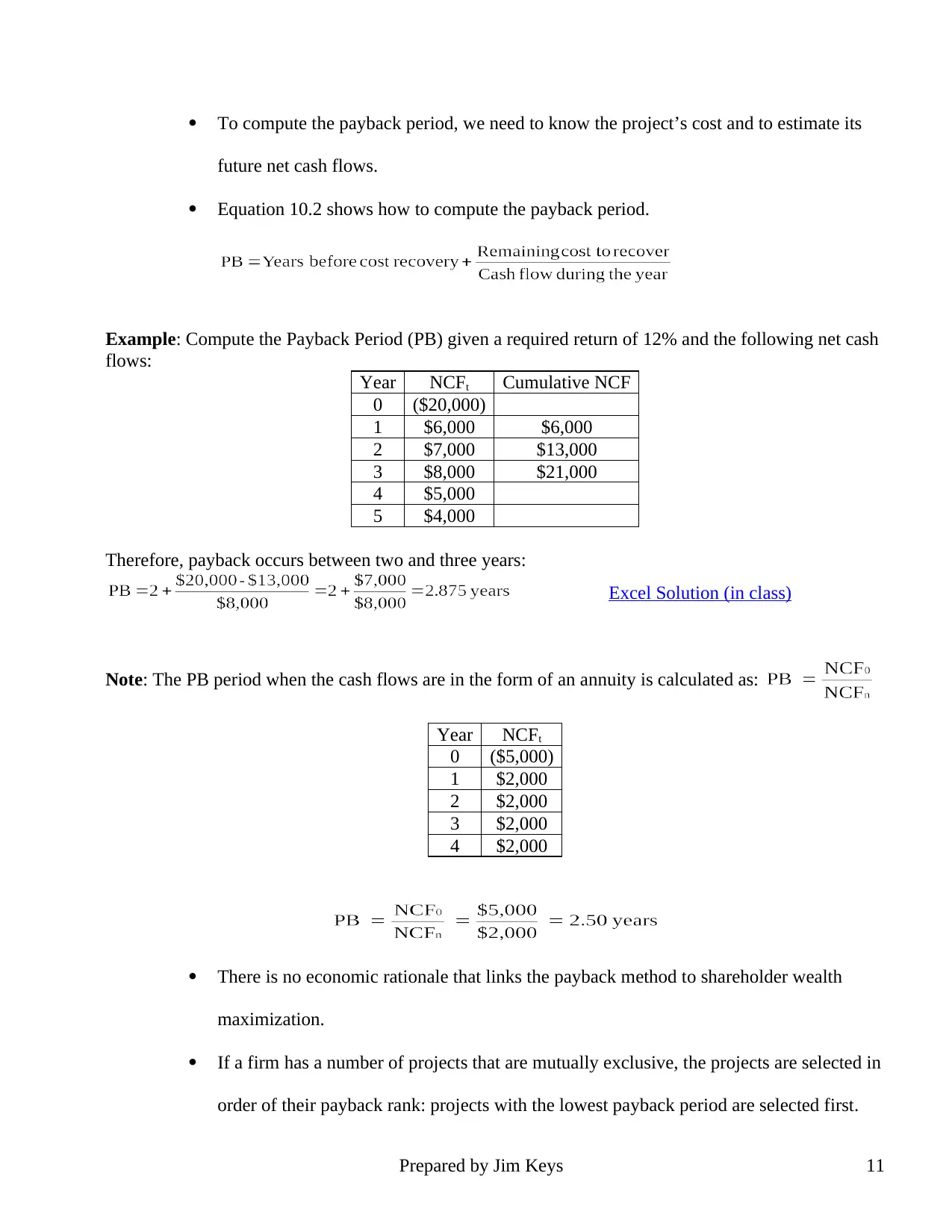
To compute the payback period, we need to know the project’s cost and to estimate its
future net cash flows.
Equation 10.2 shows how to compute the payback period.
Example: Compute the Payback Period (PB) given a required return of 12% and the following net cash
flows:
Year NCFt Cumulative NCF
0 ($20,000)
1 $6,000 $6,000
2 $7,000 $13,000
3 $8,000 $21,000
4 $5,000
5 $4,000
Therefore, payback occurs between two and three years:
Excel Solution (in class)
Note: The PB period when the cash flows are in the form of an annuity is calculated as:
Year NCFt
0 ($5,000)
1 $2,000
2 $2,000
3 $2,000
4 $2,000
There is no economic rationale that links the payback method to shareholder wealth
maximization.
If a firm has a number of projects that are mutually exclusive, the projects are selected in
order of their payback rank: projects with the lowest payback period are selected first.
Prepared by Jim Keys 11
future net cash flows.
Equation 10.2 shows how to compute the payback period.
Example: Compute the Payback Period (PB) given a required return of 12% and the following net cash
flows:
Year NCFt Cumulative NCF
0 ($20,000)
1 $6,000 $6,000
2 $7,000 $13,000
3 $8,000 $21,000
4 $5,000
5 $4,000
Therefore, payback occurs between two and three years:
Excel Solution (in class)
Note: The PB period when the cash flows are in the form of an annuity is calculated as:
Year NCFt
0 ($5,000)
1 $2,000
2 $2,000
3 $2,000
4 $2,000
There is no economic rationale that links the payback method to shareholder wealth
maximization.
If a firm has a number of projects that are mutually exclusive, the projects are selected in
order of their payback rank: projects with the lowest payback period are selected first.
Prepared by Jim Keys 11
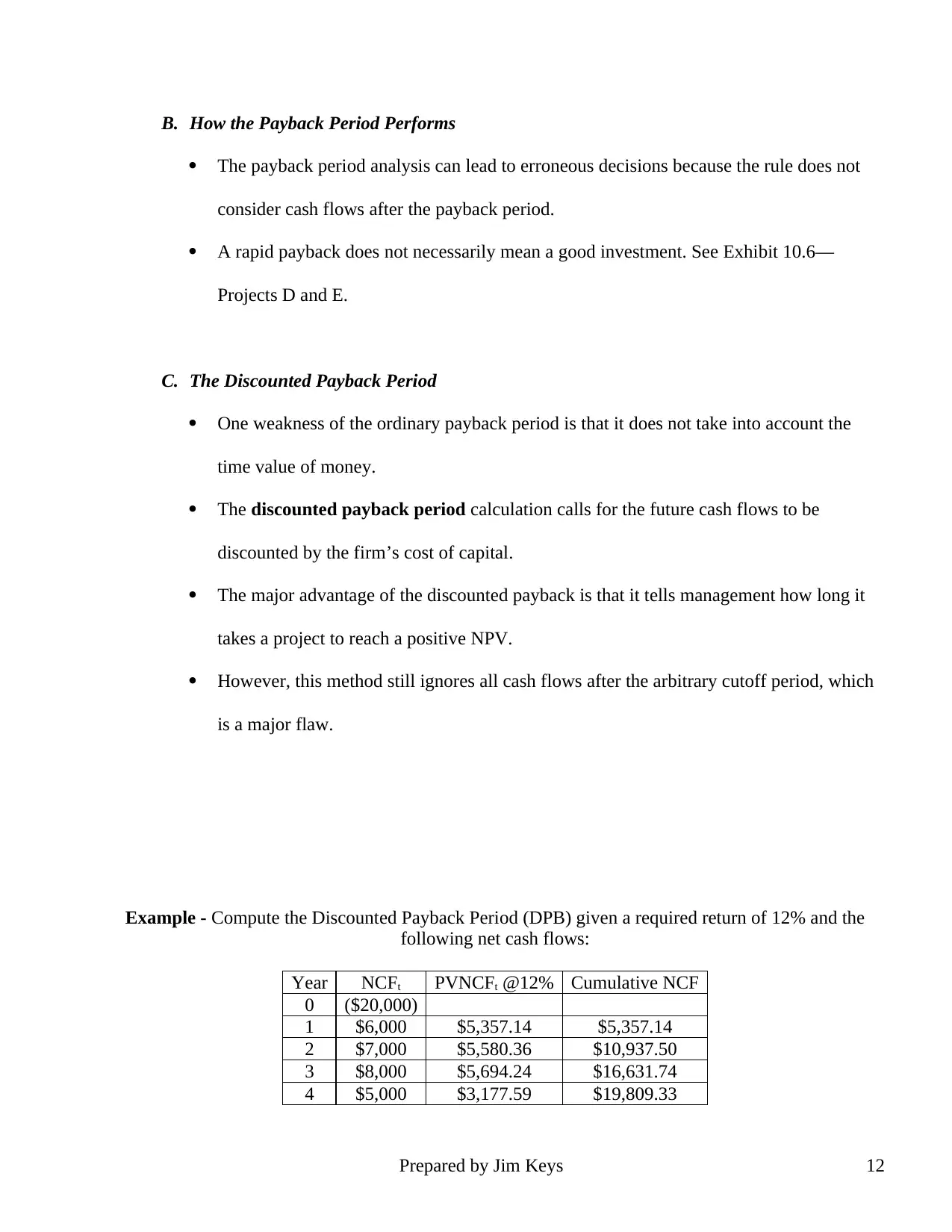
B. How the Payback Period Performs
The payback period analysis can lead to erroneous decisions because the rule does not
consider cash flows after the payback period.
A rapid payback does not necessarily mean a good investment. See Exhibit 10.6—
Projects D and E.
C. The Discounted Payback Period
One weakness of the ordinary payback period is that it does not take into account the
time value of money.
The discounted payback period calculation calls for the future cash flows to be
discounted by the firm’s cost of capital.
The major advantage of the discounted payback is that it tells management how long it
takes a project to reach a positive NPV.
However, this method still ignores all cash flows after the arbitrary cutoff period, which
is a major flaw.
Example - Compute the Discounted Payback Period (DPB) given a required return of 12% and the
following net cash flows:
Year NCFt PVNCFt @12% Cumulative NCF
0 ($20,000)
1 $6,000 $5,357.14 $5,357.14
2 $7,000 $5,580.36 $10,937.50
3 $8,000 $5,694.24 $16,631.74
4 $5,000 $3,177.59 $19,809.33
Prepared by Jim Keys 12
The payback period analysis can lead to erroneous decisions because the rule does not
consider cash flows after the payback period.
A rapid payback does not necessarily mean a good investment. See Exhibit 10.6—
Projects D and E.
C. The Discounted Payback Period
One weakness of the ordinary payback period is that it does not take into account the
time value of money.
The discounted payback period calculation calls for the future cash flows to be
discounted by the firm’s cost of capital.
The major advantage of the discounted payback is that it tells management how long it
takes a project to reach a positive NPV.
However, this method still ignores all cash flows after the arbitrary cutoff period, which
is a major flaw.
Example - Compute the Discounted Payback Period (DPB) given a required return of 12% and the
following net cash flows:
Year NCFt PVNCFt @12% Cumulative NCF
0 ($20,000)
1 $6,000 $5,357.14 $5,357.14
2 $7,000 $5,580.36 $10,937.50
3 $8,000 $5,694.24 $16,631.74
4 $5,000 $3,177.59 $19,809.33
Prepared by Jim Keys 12
⊘ This is a preview!⊘
Do you want full access?
Subscribe today to unlock all pages.

Trusted by 1+ million students worldwide
1 out of 34
Related Documents
Your All-in-One AI-Powered Toolkit for Academic Success.
+13062052269
info@desklib.com
Available 24*7 on WhatsApp / Email
![[object Object]](/_next/static/media/star-bottom.7253800d.svg)
Unlock your academic potential
Copyright © 2020–2025 A2Z Services. All Rights Reserved. Developed and managed by ZUCOL.




